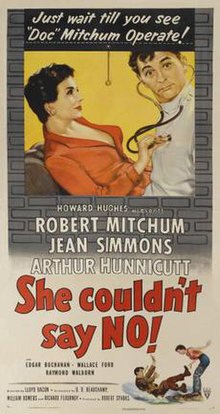She Couldn't Say No is a 1954 American rural comedy film[1] starring Robert Mitchum, Jean Simmons and Arthur Hunnicutt. It was the last film in the long directing career of Lloyd Bacon to be released (The last film he directed was the musical The French Line starring Jane Russell).
| She Couldn't Say No | |
|---|---|
 Theatrical release poster | |
| Directed by | Lloyd Bacon |
| Screenplay by | D. D. Beauchamp, William Bowers Richard Flournoy |
| Based on | Enough for Happiness 1951 American Magazine story by D. D. Beauchamp |
| Produced by | Robert Sparks |
| Starring | Robert Mitchum Jean Simmons Arthur Hunnicutt |
| Cinematography | Harry J. Wild |
| Edited by | George Amy |
| Music by | Roy Webb |
Production company | |
| Distributed by | RKO Pictures |
Release date |
|
Running time | 88 minutes[1] |
| Country | United States |
| Language | English |
"She Couldn't Say No" was later re-released as Beautiful but Dangerous.
Plot
editWealthy Corby Lane (Jean Simmons) visits the American hamlet of Progress, Arkansas, whose residents had paid for a critical medical operation for her when she was a child. She decides to express her gratitude by giving them money anonymously. The headstrong woman clashes with the local doctor, Robert Sellers (Robert Mitchum), who foresees the resulting chaos.
Cast
edit
|
- Source:[1]
Cast notes:
- Robert Mitchum disliked the script for the film so much that at one point he went on suspension to avoid appearing in it. It was not the last film he made for RKO, but it was his last RKO film to be released.[1]
Production
editParamount Pictures originally purchased the property as a vehicle for William Holden, with Dick Powell scheduled to direct, but conflicts with Holden's schedule caused the studio to sell the rights to RKO. The working title for the film was changed from "A Likely Story" to "Beautiful but Dangerous" to avoid confusion with RKO's earlier film A Likely Story, released in 1946. Other working or alternate titles included "Enough for Happiness", "Murder", and "She Had to Say Yes". Principal photography took place between the middle of May and early June 1952.[1]
References
edit- ^ a b c d e She Couldn't Say No at the AFI Catalog of Feature Films